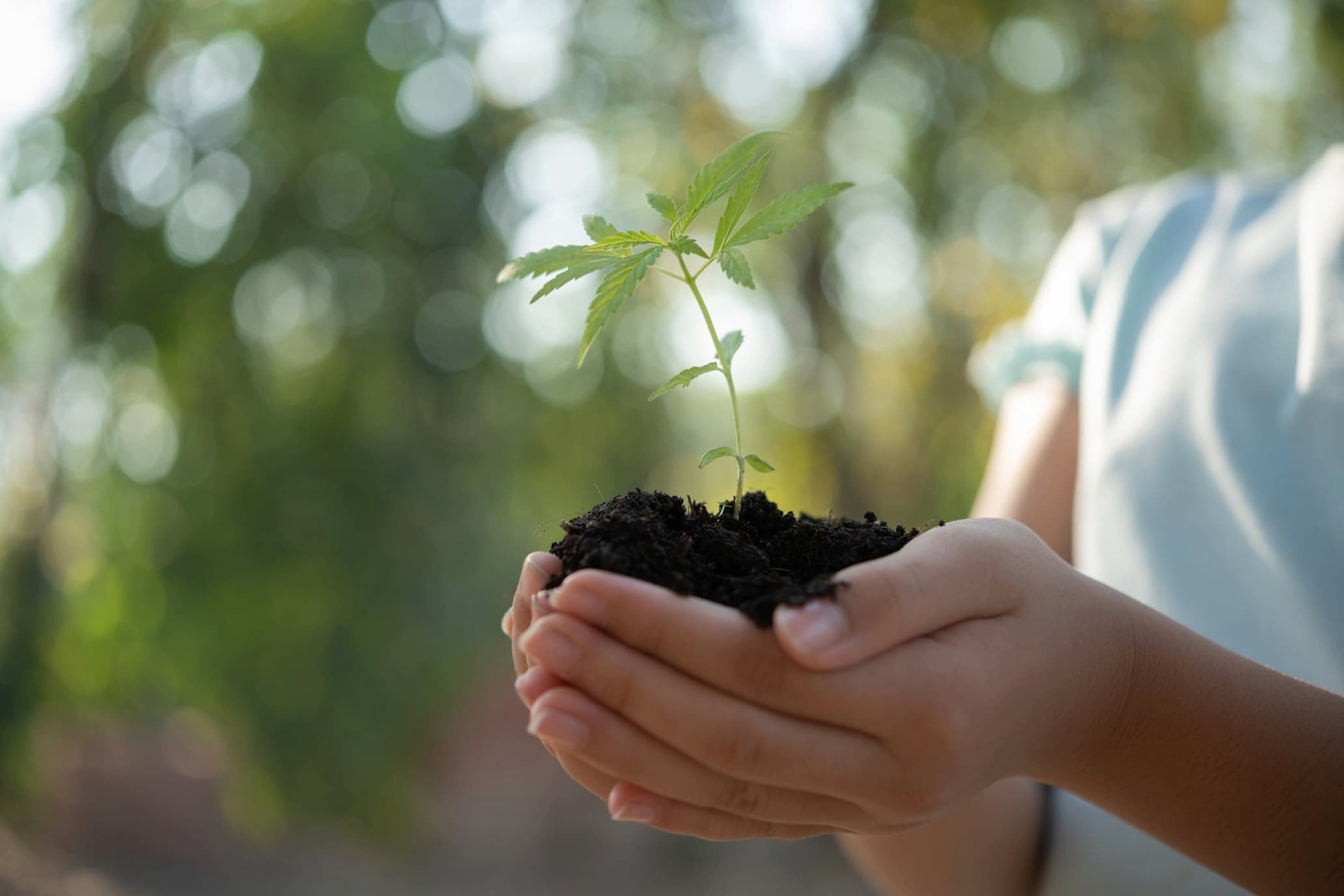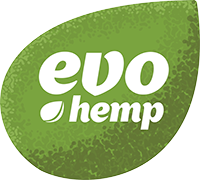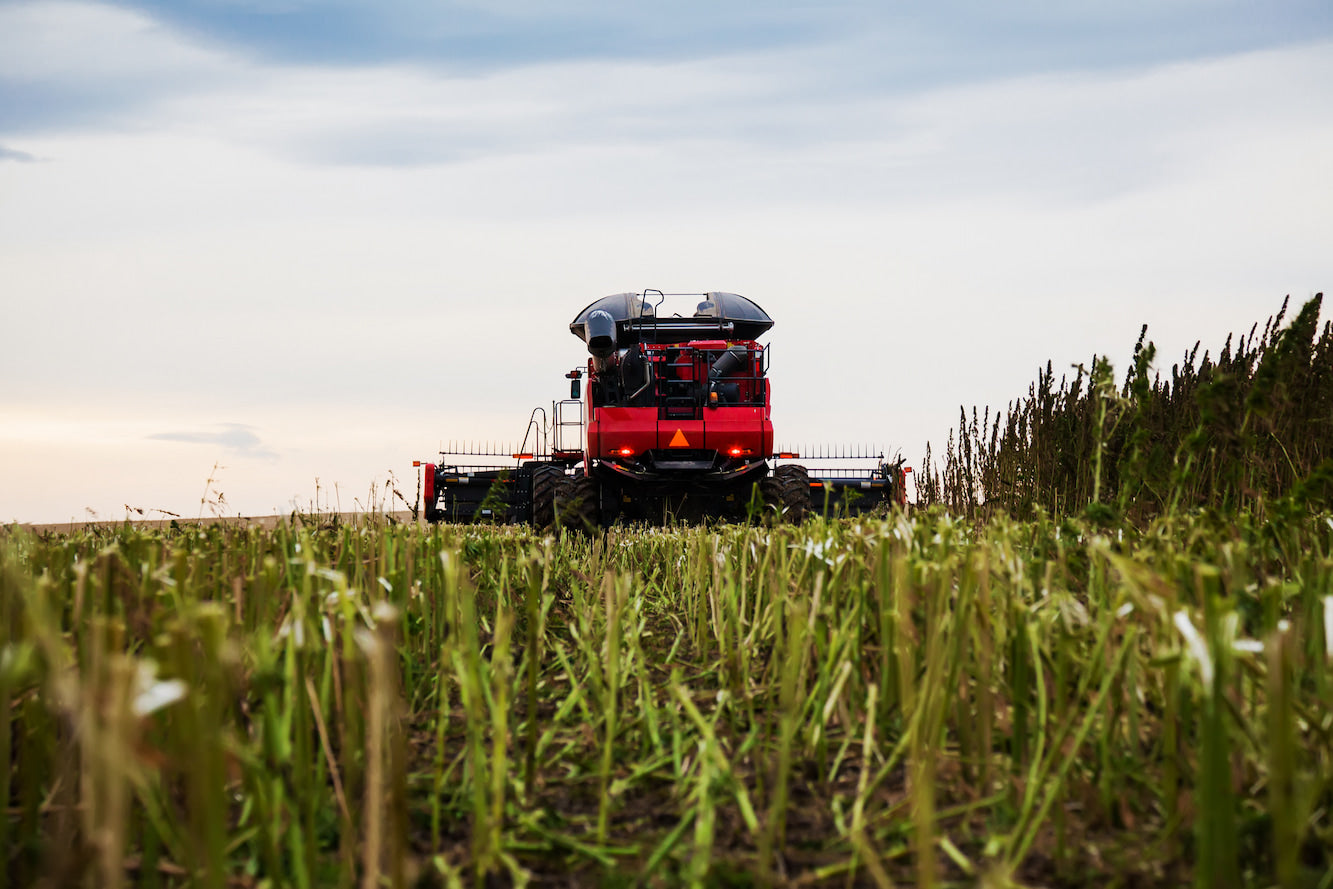Growing Your Own Hemp: An Aspiring Green Thumb's Guide

An interest in gardening is growing fast and strong, and here at evo hemp, we are fully embracing its bloom.
Gardening can serve as a way to form and feed community, engage in community care, reexamine where food comes from and the role it plays in society, ground and center yourself, engage in a relaxing and nourishing hobby, live more sustainably, and feel more connected to nature and the larger world around you.
Yeah, it does a lot, and we are here for it.
In fact, it is estimated that over 20 million people began gardening during the first year of the pandemic, and more aspiring green thumbs are expected to take root in the year to come. If you are one of them, you may be looking for the perfect plant to grow.
And if you are familiar with the many benefits that hemp has to offer, you may be wondering: can I grow my own hemp at home?
Read on to learn more about what is required to grow your own hemp, how to get started, and what you need to know!
What Is Hemp?
Hemp is a sustainable, versatile, and environmentally friendly crop. Derived from the Cannabis sativa plant (the lower-THC sibling of the marijuana plant) the hemp crop is one of the oldest cultivated crops in human history.
Hemp is considered a superfood with high nutritional value, and can be used as an environmentally friendly alternative to plastics, papers, and textiles. Growing hemp also requires little water and fertilizer, and reintroduces nutrients into the soil, making it more sustainable than many other common crops such as corn and soy.
But for decades, no one in the U.S. was legally allowed to grow hemp.
A Brief History of Hemp in the U.S.
Hemp had been grown in the Americas, along with other parts of the world, for thousands of years. It wasn’t until 1957 that the commercial cultivation of hemp was federally banned in the U.S., largely due to fear-mongering around cannabis use that was heavily tied to racist and anti-immigration sentiments.
Hemp use was further restricted with the 1970 Controlled Substances Act, which classified hemp as a Schedule 1 drug, making it illegal to grow anywhere in the United States.
Federally, things began to shift with a provision in the 2014 Farm Bill that gave states the ability to cultivate hemp and hemp fibers through research and pilot programs. While this did not legalize the growth of hemp, it did provide states with more flexibility to explore hemp production.
Finally, commercial hemp cultivation became federally legal once again after the 2018 Farm Bill passed, although cannabis cultivation is only legal on a state-by-state basis. The bill also removed hemp from the list of Schedule 1 controlled substances, labeling it instead as an agricultural product.
But, before you start seeking out hemp seeds for your acres, hang tight. There are a few more things you need to know.
Hemp vs. Cannabis: Is There a Difference?
Despite decades of misinformation, hemp and cannabis are not separate species of plants.
Both hemp and cannabis originate from the cannabis plant, from the plant family Cannabaceae. The subspecies (Cannabis sativa and Cannabis indica) are legally classified as “hemp” or “cannabis” plants based on their tetrahydrocannabinol (THC) content, even though they are technically both cannabis.
“Hemp” is used to refer to any variety of plant that has less than 0.3% THC levels, while “cannabis” is used to refer to any subspecies of the cannabis plant that contains more than that federally legal limit.
Is this massively confusing labeling a little annoying? Absolutely. But, we’ll take a little misguided labeling over decades more of misguided law-making (insert eyes emoji).
Is Growing My Own Hemp Legal?
After hemp’s long and winding journey in the U.S. legal system, the current answer to this question is unfortunately somewhat complicated: it depends.
You see, the 2018 Farm Bill only covered hemp cultivation for commercial use, not personal use, and the bill requires that all commercial production of hemp is registered with the state or federal government.
That means that to grow commercially, you need to follow the specific rules of your state’s application process (and often pay an application fee), get approval for a hemp license, and follow your state's specific guidelines and requirements for inspection and THC testing. This often includes minimum growth requirements that are costly and unattainable for the gardening hobbyist or casual hemp growers.
So what about home cultivating? This is legal only in states that allow the cultivation of cannabis (i.e. plants that contain over 0.3% THC content).
In What States Can I Grow My Own Hemp?
If you live in a state where recreational cannabis use is legal, you’re in luck! Growing your own hemp is an option for you. However, each state has different guidelines, so you want to check in on the specific rules for where you live.
In Colorado and California for instance, current state laws allow you to grow no more than six hemp and/or cannabis plants total, and only three can be mature at once. In Maine, on the other hand, anyone over 21 can have up to six mature hemp and/or cannabis plants, or 12 immature plants at once.
If recreational cannabis use is not yet allowed in your state, then unfortunately it is not currently legal for you to grow hemp at home. However, state laws are changing fast, so it’s a good idea to check your state's agricultural department website or the National Conference of State Legislatures list of state-level hemp statutes to stay up to date on hemp growing regulations.
Regardless of state, it is also worth noting that federal law requires any cannabis growth to take place outside of public view. So if your state allows cannabis cultivation, you’d still need to grow your hemp indoors or in a covered tent or greenhouse.
At this time, any outdoor hemp cultivation without a commercial license from your state could result in legal action.
Do I Need a License To Grow Hemp?
You only need a license to grow hemp commercially. If you live in a state where it is legal to cultivate cannabis, you do not need to go through any legal application process before planting your hemp seeds.
Why Grow Hemp?
If you’re somewhat new to gardening, growing hemp is a great option because it ultimately requires very little maintenance (read: it’s hard to mess up!). Hemp does not need a lot of water or space to grow, and does not require any fertilizer, either.
Every part of the hemp plant can be used. The fibrous stalks can be used in textiles, the leaves can be steeped to make tea, and the seeds are a nutritious superfood. The roots of the hemp plant can even absorb toxins and pollutants out of the soil it is planted in.
If you are interested in the many benefits hemp produces, read on to learn exactly how to begin the process of growing and caring for your own hemp plants!
What Strains of the Cannabis Plant Should I Grow?
There are many varying strains and hybrids of the cannabis plant. When choosing a subspecies of the hemp plant, consider what you want to use the hemp for.
It’s also important toverify the THC content in whichever strains you are considering to ensure that you aren’t breaking any of the rules in your specific state since some strains are bred to have more or less THC than others.
When it comes to cultivating CBD, popular choices include the Carmagnola, Charlotte’s Web, ACDC, Eletta Campana, Finola, Felina 34, and Future 75, as these options have high levels of CBD and terpenes.
Growing Hemp: What To Know
Hemp plants will have four varying growing stages: germination, seedling, vegetative, and flowering. Hemp plants typically take between 60 and 120 days to fully grow to maturity.
Indoor vs. Outdoor Growing
We recommend growing hemp indoors, as this allows for more flexibility in controlling and monitoring the conditions your plant grows in.
Because Cannabis sativa is photoperiodic, it will only grow flowers when it is in darkness for approximately 12 hours. If your plant gets over 12 hours of light, it remains vegetative and does not produce flowers. By growing indoors, you can use artificial light to control flowering production, regardless of how long or short the days are outside your windows.
If you do decide to grow hemp outside, there are a few things to keep in mind:
- Seeds should be sown directly in the ground, not in transport pots.
- Do not germinate seeds until the risk of frost has passed.
- The hemp plant has an amazing ability to absorb toxins, pollutants, and chemicals from the soil. While this makes them a great option for healing soil and supporting the environment, you don’t want to consume any plant that may have absorbed any toxins. If you plan on harvesting any part of the plant for consumption, make sure you grow your plants in healthy, clean, organic soil.
- Also remember that no state allows hemp plants to grow in public sight without a commercial license, so you’ll need to keep your hemp covered if you decide to grow it in your yard.
Female vs. Male Plants
The cannabis plants are diecious, meaning that the male and female flowers grow on completely separate male and female plants.
While both the male and female plants can be used to make textiles, fibers, and papers, there are some cases where you will only want the female plant.
If you are hoping to harvest hemp flowers or cultivate CBD, for instance, you’ll want to grow only female plants. That said, pollinated female plants are also the ones that produce new seeds.
When you germinate hemp seed, typically half of the plants will be female and half will be male. If you only want the female plant, however, you can buy a "feminized" seed, which will produce only female plants.
Starting Out: Germination
Here is how to get started:
- Pre-soak seeds for 8-12 hours. This will help make the seed better able to put out shoots in the coming days.
- If planting indoors, plant seeds 1-inch deep in moist, well-draining soil within root cells or plugs. If growing outdoors, seeds can be densely planted close together directly into soil that is well-draining and heavy in organic matter.
For indoor growth, you may want to use a seedling heat mat, thermostat, and humidity dome to help control the soil temperature and humidity levels.
The hemp plant excels in warm weather and well-drained soils. For best results, seed germination should take place in a room with the temperature set to 65-70 degrees. Hemp will not grow as well in wet or clay-heavy soils.
Humidity level is also extremely important when it comes to germinating hemp seeds. You want to aim for a relative humidity of 80-90% during the germination phase, as well as the first ten days after the seeds have sprouted into seedlings.
Because the hemp plants in these early stages of life do not yet have a robust radicular system, they are quite fragile. They need higher moisture levels than matured hemp plants so they can focus their resources on developing a vigorous and sturdy root mass.
Stage Two: Seedlings
Your seeds should begin to grow shoots within five days to two weeks of germinating.
At this stage, you will want to keep the following in mind:
- Temperature: Seedlings should be kept between 68 to 77 degrees F.
- Relative Humidity: Seedlings still require high humidity to keep them protected. Relative humidity should stay between 65-70% in the first two weeks after the shoots come up.
- Light: Seedlings require 18 to 24 hours of light a day to support their growth. High-output LED or T5 fluorescent grow lamps placed a few inches above the seedlings can help provide ample light throughout the day. If seedlings become leggy, it means they are needing to stretch too far to get the light they need, and the grow lamps should be lowered.
- Feed: Fertilize your seedlings with a nitrogen-rich and water-soluble fertilizer. At this phase, you’ll want to water seedlings using a fertilizer with a target 3:1:2 NPK ratio at 1/4th the recommended application strength up until the first transplant.
Transplanting Notes:
- First transplant: Once the seedlings have rooted to the bottom of the cell, transplant into a four or five-inch pot.
- Second (and final) transplant: When the transplants have rooted to the bottom and sides of the pot, they are ready to be transplanted once more into a larger pot or fabric grow bag. You’ll also want to switch to a slightly heavier potting mix containing organic matter.
While more mature hemp plants require very little water, the seedlings at this stage do need to be watered whenever the soil is dry below the top layer. Soil should be kept wet, but not moist.
Phase Three: Growing Vegetative Hemp Plants
After the seedlings have been moved to their final pot and entered their more substantive growing phase, the growing environment must shift to better support their vegetative growth period.
- Temperature: Young vegetative transplants do best when kept between 70 and 82 degrees F. Once the plant is slightly further along in the vegetative growth process, the temperature can be lowered to between 60 and 80 degrees F.
- Relative Humidity: Relative humidity should be kept within the 40-70% range. As the vegetative plant grows, its radicular function becomes stronger, allowing the plant to absorb more nutrients and develop a better immune system. At this point in the growth cycle, the hemp plant becomes more resistant and requires less humidity.
- Light: Your vegetative plant will continue to need 18 to 24 hours of light per day. This amount of light will keep your plants from flowering, and instead stimulate more leaf growth.
- Water and Feed: The root zone of the hemp plant during the vegetative phase should be kept moist, but not soggy. Water the plant whenever the soil is dried out, and consider rainfall. At this stage, you’ll fertilize the plant weekly as needed using a nitrogen-rich and natural liquid fertilizer with a target 3:1:2 NPK ratio. Your hemp plant will grow best in loose soil with an average pH of 6.0 to 7.0.
Phase Four: Growing Flowering Hemp Plants
The flowering phase begins after the final stretching or growth boost takes place, typically 30 to 60 days after the vegetative stage begins.
If you want your hemp plant to produce cannabinoid-rich flowers, another shift in growing conditions is needed.
- Temperature: Flowering is most likely to occur when the temperature is lowered to between 68 and 77 degrees F.
- Relative Humidity: Mature plants do not need humidity any higher than the 40-50% range.
- Light: Once your plant has had 30 to 60 days of vegetative growth, you can start to stimulate flower production by limiting light times to 12 hours per day. During the other 12 hours, hemp plants must be shrouded in complete darkness.
- Water and Feed: Be careful not to over-water flowering plants. While you do not need as much water during this stage, soil should remain relatively moist, and should not become regularly dried out. Using a liquid fertilizer that contains nitrogen, phosphorus, and potassium with a target NPK ratio of 1:3:4 weekly can also help support healthy flower production.
- Air circulation: At this stage, it is critical to keep air flowing. Adding a small fan to your indoor hemp garden can help limit pests, prevent leaf fungal diseases, and help the plants remain cool even when heat is produced by the grow lamps.
Final Thoughts
Whether you are growing hemp plants as a fun new challenge, or to cultivate the hemp to ultimately take advantage of its nourishing properties, you can feel good connecting with this sustainable and carbon-capturing crop.
Looking for ways to enjoy hemp before your own finally flowers? Check out our hemp-based snacks, oils, and more at the evo hemp Shop!
Sources:
State Industrial Hemp Statutes | National Conference of State Legislatures
- Tags: farming



